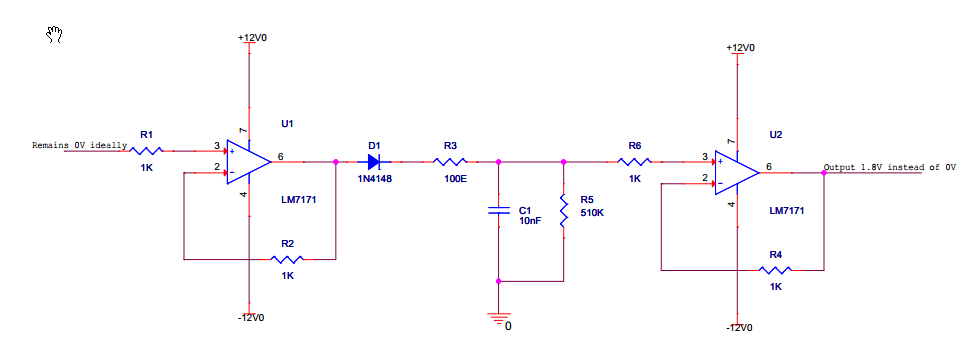I am facing strange problem regarding voltage follower output.
I am using LM7171 Op-Amp as a voltage follower with dual power supply that is +/-12V.
Description of circuit is as below:
This circuit is worked as a peak detector.
ideally my input signal at the first stage remains 80mV to -80mV. (almost 0V).
i have checked the output of U1( first stage voltage follower), it is ok. that is i get 80mV to -80mV. (almost 0V).
but if i check the output of final stage voltage follower U2, it shows 1.8V instead of nearly 0V.
ideally, when input signal remains 0V, then diode D1 will not conduct, & it will act as open circuit.
if op-amp's input terminal left floating, then output of op-amp will be uncertain.
So, i have pulled down non inverting terminal of U2 with R5 (510K).
if i have not pulled it down, then output of U2 will be saturated in positive side.
Now, the strange problem is here.
if i use 10K instead of 510K, then the output of U2, remains close to 0V. that is (150mV to 100mV).
when i increasing the value of R5, the output of U2 is also increasing.
Some practical result is as below:
100K - 800mV
510K - 1.8V
1M - 2.4V
I can not use small value( less then 510K) for R5, as if i use small value of R5, capacitor C1 will be quickly discharged through it.
also i can not increase the value of C1, because number of signals for making peak is limited that is 500 signals.( in 500 signals , the out put of this circuit must show the peak value.)
i have also used decoupling capacitor at both power supply, as mentioned in the datasheet. ( these capacitors can't be seen in above circuit).
So, if i use 1M for R5, i will not able to detect peak which is less then 2.4V.
So, how can i solve this problem, without affecting peak detection accuracy.
Thanks in advance.



